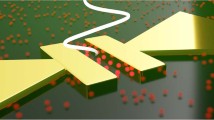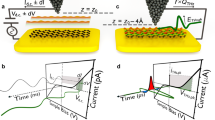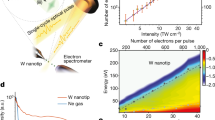Abstract
Tailored nanostructures can confine electromagnetic waveforms in extremely sub-wavelength volumes, opening new avenues in lightwave sensing and control down to sub-molecular resolution. Atomic light–matter interaction depends critically on the absolute strength and the precise time evolution of the near field, which may be strongly influenced by quantum-mechanical effects. However, measuring atom-scale field transients has remained out of reach. Here we introduce quantitative atomic-scale waveform sampling in lightwave scanning tunnelling microscopy to resolve a tip-confined near-field transient. Our parameter-free calibration employs a single-molecule switch as an atomic-scale voltage standard. Although salient features of the far-to-near-field transfer follow classical electrodynamics, we develop a comprehensive understanding of the atomic-scale waveforms with time-dependent density functional theory. The simulations validate our calibration and confirm that single-electron tunnelling ensures minimal back-action of the measurement process on the electromagnetic fields. Our observations access an uncharted domain of nano-opto-electronics where local quantum dynamics determine femtosecond atomic near fields.
This is a preview of subscription content, access via your institution
Access options
Access Nature and 54 other Nature Portfolio journals
Get Nature+, our best-value online-access subscription
$29.99 / 30 days
cancel any time
Subscribe to this journal
Receive 12 print issues and online access
$209.00 per year
only $17.42 per issue
Buy this article
- Purchase on Springer Link
- Instant access to full article PDF
Prices may be subject to local taxes which are calculated during checkout




Similar content being viewed by others
Data availability
The data that support the plots within this paper and other findings of this study are available from the corresponding authors upon reasonable request.
References
Wu, Q. & Zang, X.-C. Free-space electro-optic sampling of terahertz beams. Appl. Phys. Lett. 67, 3523–3525 (1995).
Kübler, C., Huber, R., Tübel, S. & Leitenstorfer, A. Ultrabroadband detection of multi-terahertz field transients with GaSe electro-optic sensors: approaching the near infrared. Appl. Phys. Lett. 85, 3360–3362 (2004).
Liu, W. et al. A fully reconfigurable photonic integrated signal processor. Nat. Photon. 10, 190–195 (2016).
Sederberg, S. et al. Attosecond optoelectronic field measurement in solids. Nat. Commun. 11, 430 (2020).
Paul, P. M. et al. Observation of a train of attosecond pulses from high harmonic generation. Science 292, 1689–1692 (2001).
Huber, R. et al. How many-particle interactions develop after ultrafast excitation of an electron–hole plasma. Nature 414, 286–289 (2001).
Drescher, M. et al. Time-resolved atomic inner-shell spectroscopy. Nature 419, 803–807 (2002).
Kienberger, R. et al. Atomic transient recorder. Nature 427, 817–821 (2004).
Dudovich, N. et al. Measuring and controlling the birth of attosecond XUV pulses. Nat. Phys. 2, 781–786 (2006).
Corkum, P. B. & Krausz, F. Attosecond science. Nat. Phys. 3, 381–387 (2007).
Goulielmakis, E. et al. Attosecond control and measurement: lightwave electronics. Science 317, 769–775 (2007).
Eisele, M. et al. Ultrafast multi-terahertz nano-spectroscopy with sub-cycle temporal resolution. Nat. Photon. 8, 841–845 (2014).
Basov, D. N., Fogler, M. M. & García De Abajo, F. J. Polaritons in van der Waals materials. Science 354, aag1992 (2016).
Merlein, J. et al. Nanomechanical control of an optical antenna. Nat. Photon. 2, 230–233 (2008).
Liu, M. et al. Terahertz-field-induced insulator-to-metal transition in vanadium dioxide metamaterial. Nature 487, 345–348 (2012).
Yoshida, K., Shibata, K. & Hirakawa, K. Terahertz field enhancement and photon-assisted tunneling in single-molecule transistors. Phys. Rev. Lett. 115, 138302 (2015).
Spektor, G. et al. Revealing the subfemtosecond dynamics of orbital angular momentum in nanoplasmonic vortices. Science 355, 1187–1191 (2017).
Esmann, M. et al. Vectorial near-field coupling. Nat. Nanotechnol. 14, 698–704 (2019).
Seo, M. A. et al. Terahertz field enhancement by a metallic nano slit operating beyond the skin-depth limit. Nat. Photon. 3, 152–156 (2009).
Savage, K. J. et al. Revealing the quantum regime in tunnelling plasmonics. Nature 491, 574–577 (2012).
Benz, F. et al. Single-molecule optomechanics in ‘picocavities’. Science 354, 726–729 (2016).
Krüger, M., Schenk, M. & Hommelhoff, P. Attosecond control of electrons emitted from a nanoscale metal tip. Nature 475, 78–81 (2011).
Herink, G., Solli, D. R., Gulde, M. & Ropers, C. Field-driven photoemission from nanostructures quenches the quiver motion. Nature 483, 190–193 (2012).
Förg, B. et al. Attosecond nanoscale near-field sampling. Nat. Commun. 7, 11717 (2016).
Rybka, T. et al. Sub-cycle optical phase control of nanotunnelling in the single-electron regime. Nat. Photon. 10, 667–670 (2016).
Barnes, W. L., Dereux, A. & Ebbesen, T. W. Surface plasmon subwavelength optics. Nature 424, 824–830 (2003).
Cocker, T. L. et al. An ultrafast terahertz scanning tunnelling microscope. Nat. Photon. 7, 620–625 (2013).
Cocker, T. L., Peller, D., Yu, P., Repp, J. & Huber, R. Tracking the ultrafast motion of a single molecule by femtosecond orbital imaging. Nature 539, 263–267 (2016).
Yoshioka, K. et al. Real-space coherent manipulation of electrons in a single tunnel junction by single-cycle terahertz electric fields. Nat. Photon. 10, 762–765 (2016).
Jelic, V. et al. Ultrafast terahertz control of extreme tunnel currents through single atoms on a silicon surface. Nat. Phys. 13, 591–597 (2017).
Yoshioka, K. et al. Tailoring single-cycle near field in a tunnel junction with carrier-envelope phase-controlled terahertz electric fields. Nano Lett. 18, 5198–5204 (2018).
Li, S., Chen, S., Li, J., Wu, R. & Ho, W. Joint space–time coherent vibration driven conformational transitions in a single molecule. Phys. Rev. Lett. 119, 176002 (2017).
Böckmann, H. et al. Near-field enhanced photochemistry of single molecules in a scanning tunneling microscope junction. Nano Lett. 18, 152–157 (2018).
Lee, J., Crampton, K. T., Tallarida, N. & Apkarian, V. A. Visualizing vibrational normal modes of a single molecule with atomically confined light. Nature 568, 78–82 (2019).
Kubo, A., Pontius, N. & Petek, H. Femtosecond microscopy of surface plasmon polariton wave packet evolution at the silver/vacuum interface. Nano Lett. 7, 470–475 (2007).
Barbry, M. et al. Atomistic near-field nanoplasmonics: reaching atomic-scale resolution in nanooptics. Nano Lett. 15, 3410–3419 (2015).
Rácz, P. et al. Measurement of nanoplasmonic field enhancement with ultrafast photoemission. Nano Lett. 17, 1181–1186 (2017).
Yoshida, S. et al. Subcycle transient scanning tunneling spectroscopy with visualization of enhanced terahertz near field. ACS Photonics 6, 1356–1364 (2019).
Jestädt, R., Ruggenthaler, M., Oliveira, M. J. T., Rubio, A. & Appel, H. Light–matter interactions within the Ehrenfest–Maxwell–Pauli–Kohn–Sham framework: fundamentals, implementation and nano-optical application. Adv. Phys. 68, 225–333 (2019).
Peller, D. et al. Sub-cycle atomic-scale forces coherently control a single-molecule switch. Nature 585, 58–62 (2020).
Patera, L. L., Queck, F., Scheuerer, P., Moll, N. & Repp, J. Accessing a charged intermediate state involved in the excitation of single molecules. Phys. Rev. Lett. 123, 016001 (2019).
Repp, J., Meyer, G., Paavilainen, S., Olsson, F. & Persson, M. Phys. Rev. Lett. 95, 225503 (2005).
Ordal, M. A. et al. Optical properties of the metals Al, Co, Cu, Au, Fe, Pb, Ni, Pd, Pt, Ag, Ti and W in the infrared and far infrared. Appl. Opt. 22, 1099–1119 (1983).
Olmon, R. L. et al. Optical dielectric function of gold. Phys. Rev. B 86, 235147 (2012).
Kang, J. H., Kim, D. S. & Park, Q.-H. Local capacitor model for plasmonic electric field enhancement. Phys. Rev. Lett. 102, 093906 (2009).
Tancogne-Dejean, N. et al. Octopus, a computational framework for exploring light-driven phenomena and quantum dynamics in extended and finite systems. J. Chem. Phys. 152, 124119 (2020).
Andrade, X. et al. Real-space grids and the Octopus code as tools for the development of new simulation approaches for electronic systems. Phys. Chem. Chem. Phys. 17, 31371–31396 (2015).
Perdew, J. P. & Zunger, A. Self-interaction correction to density-functional approximations for many-electron systems. Phys. Rev. B 23, 5048–5079 (1981).
Legrand, C., Suraud, E. & Reinhard, P. G. Comparison of self-interaction-corrections for metal cluster. J. Phys. B 35, 1115–1128 (2002).
Castro, A., Marques, M. A. L. & Rubio, A. Propagators for the time-dependent Kohn–Sham equations. J. Chem. Phys. 121, 3425–3433 (2004).
Di Ventra, M. & Todorov, T. N. Transport in nanoscale systems: the microcanonical versus grand-canonical picture. J. Phys. Condens. Matter 16, 8025–8034 (2004).
Acknowledgements
We thank C. Meineke, A. Pöllmann, C. Rohrer and M. Furthmeier for assistance and F. Evers, H. Appel and S. Ohlman for discussions. We acknowledge financial support from the Deutsche Forschungsgemeinschaft (DFG, German Research Foundation) through Project-ID 314695032—SFB 1277 (Subproject B02), Research Grants HU1598/3 and HU1598/8, the Cluster of Excellence ‘Advanced Imaging of Matter’ (AIM, EXC 2056, ID 390715994) and from Grupos Consolidados (IT1249-19), the European Research Council (ERC-2015-AdG694097), the European Union’s Horizon 2020 research and innovation programme under the Marie Skłodowska-Curie grant agreement no. 895747 and the Flatiron Institute, a division of the Simons Foundation.
Author information
Authors and Affiliations
Contributions
D.P., C.R., L.Z.K., T.B., A.N., J.H., J.R. and R.H. conceived, set up and carried out the experiments. D.P. and A.N. implemented and carried out the classical finite-element simulations. F.B., D.S., M.R. and A.R. conceived, implemented and carried out the TDDFT simulations. All authors analysed the data and wrote the manuscript.
Corresponding authors
Ethics declarations
Competing interests
The authors declare no competing interests.
Additional information
Peer review information Nature Photonics thanks Kazuhiko Hirakawa, Christoph Lienau and the other, anonymous, reviewer(s) for their contribution to the peer review of this work.
Publisher’s note Springer Nature remains neutral with regard to jurisdictional claims in published maps and institutional affiliations.
Extended data
Extended Data Fig. 1 Calibrated near-field waveform for different gap sizes.
a, Three waveforms obtained in a way analogous to Fig. 3b are shown. The transients were recorded with the same molecular sensor and identical atomic shape of the tip, but only the relative tip height was varied. The exponential dependence of the tunnelling rate with tip height limits the possible variations to approximately 0.5 Å, for which the current changes already by more than a factor of three. The absolute tip-molecule distance is unknown, but can be estimated to be on the order of a few ångströms. All three datasets exhibit very similar waveforms, only the one at closest distance (yellow) is slightly reduced in amplitude. In a classical regime of electrodynamics, we expect that the gap voltage does not depend on the width of the junction, in consistency with the data. These statistical measurements at relative tip heights of 0.5 Å, 0.3 Å and 0.0 Å exhibit standard deviations of 10 mV, 5 mV and 5 mV, respectively. b, The same waveform as in panel a (0.3 Å relative tip height, apex #1) is shown together with a transient acquired with a slightly different tip termination (apex #2, standard deviation 4 mV) obtained through mechanical modification by gently indenting the tip into the sample. The latter waveform has been induced by a stronger far field. It is rescaled by a factor 0.76 in the panel for better visual comparison. The scaled profiles of both transients agree extremely well, indicating that the atomistic details of the tip apex do not affect the shape of the near-field waveform.
Extended Data Fig. 2 Parameter-free classical simulation of atomic-scale near-field coupling.
a,b, Electron microscope images of the etched tip employed in the experiments allow accurate modelling of the macroscopic geometry, opening angle and apex radius of curvature in a numerical simulation. Maxwell’s equations are solved on a graded three-dimensional mesh for complex electromagnetic fields of a given frequency. c, A cross section of the obtained field distribution for a frequency of 1 THz visualizes the real part of the electric field component perpendicular to the substrate, Ez, (normalized to this component’s excitation strength) in a colour-coded map. The pattern reveals interference of incident wavefronts with reflections off the substrate and, in the vicinity of the tip apex, field enhancement and phase retardation effects. d, Across the 1 nm gap between tip and sample, the electric field lines are vertical with field strengths enhanced by ~2 × 105. e, Extracting the field enhancement (black solid line) that the geometry induces within the tunnelling gap for different frequencies, we find a f−1-like behaviour as predicted by antenna theory (black dashed line). The simulated phase retardation is approximately constant at -π/3 rad (grey line). Both amplitude and phase of this complex transfer function exhibit the same minor periodic modulation as observed in the waveform measurement. Analysis of the spatial field distributions reveals that a weak standing wave across the etched region of the tip causes this subtle structure.
Extended Data Fig. 3 Standing wave across etched region of the tip.
a, The finite-element simulation confirms that the coupling efficiency of external lightwaves to the tunnelling junction exhibits a slight frequency-periodic modulation. The panel shows the simulated field enhancement and phase retardation at the tip apex from Extended Data Fig. 2e with arrows highlighting two local maxima and a local minimum of the modulation. b–d, The spatial field distribution at the front-most segment of the tip illustrates that the tapered region (~200 μm long) of the etched tip serves as a resonator for surface plasmons. We observe a standing wave pattern (antinodes indicated by grey arrows), giving rise to a sequence of frequencies with slightly increased or attenuated coupling efficiency.
Supplementary information
Supplementary Information
Supplementary Note 1 and Figs. 1 and 2.
Supplementary Video 1
Simulated temporal evolution of the Hartree potential comparing the set-up with molecule in the junction and the free junction. Video showing the vertical cross-section of the Hartree potential, similar to Fig. 4a,b, as it evolves over time when driven by an external waveform. Locally, the calculated Hartree potential without the molecule (left panel) and including the molecule in the junction (right panel) vary strongly. Every frame corresponds to a time step of 215 as. The colour scale indicates the Hartree potential in electronvolts.
Supplementary Video 2
Simulated temporal evolution of the Hartree potential comparing two different tip orientations. Video showing the vertical cross-section of the Hartree potential as in Supplementary Video 1 (same time step per frame). Comparing a tilted tip configuration (left panel) with a symmetric geometry (right panel), we obtain very similar spatial distributions of the potential in the vicinity of the molecule, causing similar near-field profiles. Hence the near-field is not strongly dependent on the tip symmetry or orientation. The colour scale indicates the Hartree potential in electronvolts.
Rights and permissions
About this article
Cite this article
Peller, D., Roelcke, C., Kastner, L.Z. et al. Quantitative sampling of atomic-scale electromagnetic waveforms. Nat. Photonics 15, 143–147 (2021). https://doi.org/10.1038/s41566-020-00720-8
Received:
Accepted:
Published:
Issue Date:
DOI: https://doi.org/10.1038/s41566-020-00720-8
This article is cited by
-
Ultrafast atomic-scale scanning tunnelling spectroscopy of a single vacancy in a monolayer crystal
Nature Photonics (2024)
-
Scalable high-repetition-rate sub-half-cycle terahertz pulses from spatially indirect interband transitions
Light: Science & Applications (2022)
-
Ultrafast imaging of terahertz electric waveforms using quantum dots
Light: Science & Applications (2022)
-
Terahertz near-field microscopy based on an air-plasma dynamic aperture
Light: Science & Applications (2022)
-
Subcycle contact-free nanoscopy of ultrafast interlayer transport in atomically thin heterostructures
Nature Photonics (2021)



